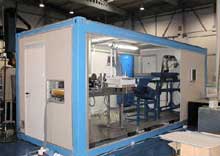`Artificial vision` for recycling copper

It’s in this machine where they recover copper from old cables
The technological centre Robotiker from Zamudio (Basque Country) has developed a system of artificial sight to separate metals that come with copper, in order to obtain high purity copper.
To recover copper from old cables it is not something new. However, the recycled copper is not pure, because it is mixed with other metals, such as lead, aluminium and tin. It is quite complicated to separate copper from those components by using mechanical, physical and other methods. Nevertheless it is easy to distinguish impurities through the eyesight.
The recycling of cables has been promoted by the need to change conventional telephone lines. The price of the material obtained from the recycling of electrical and telephone cables depends on the level of purity of the copper. Therefore, the fact of having lead, aluminium and tin along with copper determines the use and, hence, the price of copper.
With the system developed by Robotiker, after several processes the copper cable is divided into small pieces, and that divided copper has a purity of 99 %. The size of those pieces is variable, but usually it has 8-15 mm long, 3-1 mm wide and 1 mm high. When those pieces of the cable go along a belt, a camera with artificial sight can see them and differ them by the colour. If it realises it is not copper, it will reject it.
When copper has a purity of 99 %, it is used for plumbing and heating-systems. However, if it is going to be recycled for electrical use, its purity must be at least of 99.9 %. Thanks to the high purity obtained at the end of this new process, copper can be used for electrolytic processes, that is, for batteries. That was the aim of the companies that have developed the project together with Robotiker; more precisely the aim of Laining Industrial and two companies from the recycling sector Indumental Recycling and Botrade.
Thanks to this leading technique of artificial sight, materials can be separated by colour and shape. The result of this project (reduction of impurities from 10 to 1 with 1,000 Kg/hour flows) allows to expand in future such systems to other recycling processes.
Media Contact
More Information:
http://www.basqueresearch.com/index.asp?Gelaxka=1&hizk=IAll latest news from the category: Process Engineering
This special field revolves around processes for modifying material properties (milling, cooling), composition (filtration, distillation) and type (oxidation, hydration).
Valuable information is available on a broad range of technologies including material separation, laser processes, measuring techniques and robot engineering in addition to testing methods and coating and materials analysis processes.
Newest articles

High-energy-density aqueous battery based on halogen multi-electron transfer
Traditional non-aqueous lithium-ion batteries have a high energy density, but their safety is compromised due to the flammable organic electrolytes they utilize. Aqueous batteries use water as the solvent for…

First-ever combined heart pump and pig kidney transplant
…gives new hope to patient with terminal illness. Surgeons at NYU Langone Health performed the first-ever combined mechanical heart pump and gene-edited pig kidney transplant surgery in a 54-year-old woman…

Biophysics: Testing how well biomarkers work
LMU researchers have developed a method to determine how reliably target proteins can be labeled using super-resolution fluorescence microscopy. Modern microscopy techniques make it possible to examine the inner workings…





















